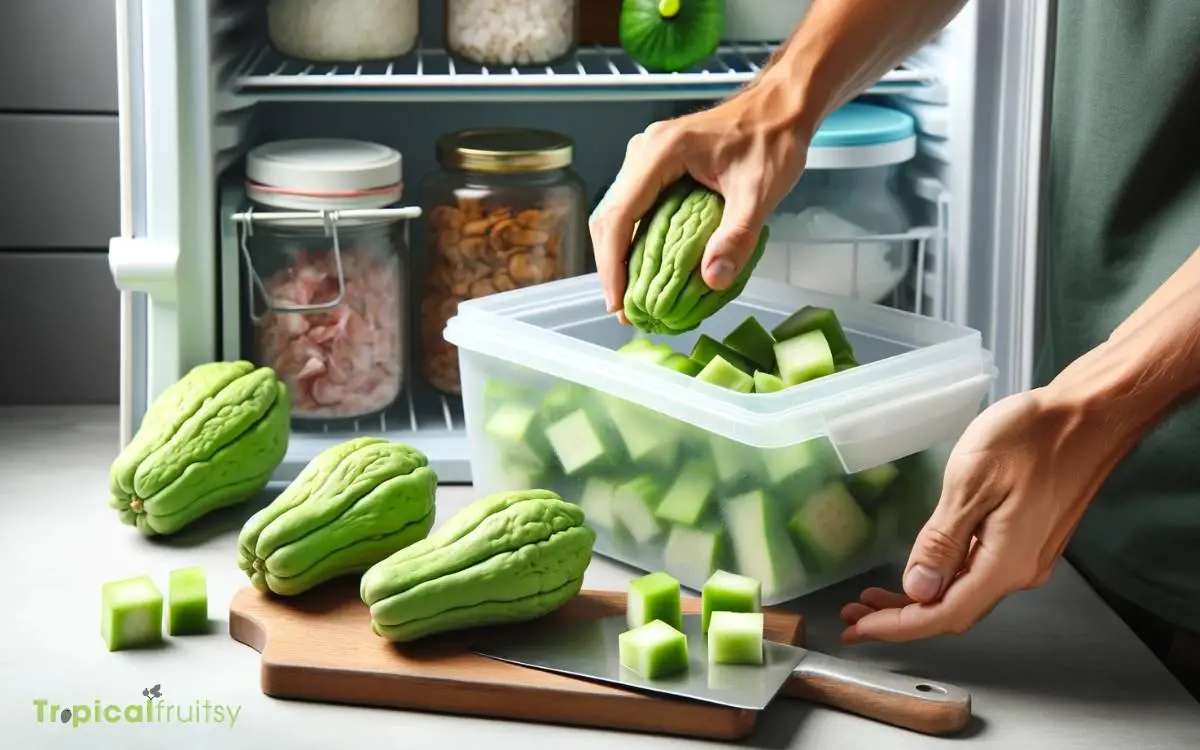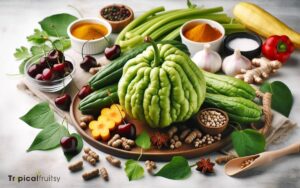Can You Freeze Chayote Squash? Yes!
Yes, you can freeze chayote squash. To do so, blanch the slices in boiling water for two minutes, plunge them into ice water to stop the cooking process, drain well, and then place them in airtight freezer bags or containers before freezing.
Chayote squash, also known as mirliton, is a versatile vegetable that can be preserved by freezing, extending its shelf life and allowing you to enjoy it out of season. Freezing slows down the enzyme activity that causes food to spoil.
Here’s how to properly freeze chayote squash:
By following these steps, you’ll have chayote squash ready to use in soups, stews, casseroles, or side dishes directly from the freezer.
Freezing chayote squash is a practical way to preserve its freshness and enjoy this versatile ingredient year-round in a variety of dishes.

Key Takeaway
Understanding Chayote Squash
We need to first explore what chayote squash is before delving into its freezing possibilities.
Chayote, also known as mirliton or vegetable pear, is a versatile gourd that’s part of the Cucurbitaceae family, which includes melons, cucumbers, and squashes. It’s native to Central America but has spread worldwide due to its adaptability and mild flavor.
Nutritionally, chayote is noteworthy for its low calories, high fiber, and vitamin C content. Its texture and taste are often compared to a cross between a potato and cucumber, making it a popular ingredient in both raw and cooked dishes.
We’ll assess how freezing affects its cell structure, flavor, and nutritional value to determine if it’s a viable preservation method.
Preparing for Freezing
Before tossing chayote squash into the freezer, one must first prepare it properly to maintain its texture and nutritional integrity.
We’ll need to clean, peel, and cut the chayote into manageable sizes. Since freezing can cause cell walls to burst, changing the texture, it’s crucial to follow these steps carefully.
| Step | Description |
|---|---|
| Cleaning | Wash the chayote thoroughly to remove any dirt. |
| Peeling | Peel off the skin, as it can become tough. |
| Cutting | Slice into desired shapes and sizes. |
| Portioning | Divide into portions for easier use later. |
| Packaging | Use airtight containers or freezer bags. |
Adhering to this process ensures the chayote remains as fresh-tasting as possible when thawed.
Blanching Process Explained
After preparing the chayote squash for freezing, it’s crucial to blanch it to preserve its flavor and texture.
The blanching process involves boiling the chayote pieces for a brief period, then rapidly cooling them in an ice water bath. This halts the enzymatic activity that can cause spoilage and loss of quality.
Typically, we blanch chayote for two to three minutes before cooling it promptly. It’s essential to maintain this time frame to prevent the squash from becoming too soft or losing its nutritional value.
Moreover, the quick transition from hot to cold seals in the freshness, ensuring that the chayote maintains its peak condition.
With the blanching complete, we’ll next focus on proper storage techniques to maximize shelf life.
Proper Storage Techniques
Having blanched the chayote squash, we’ll now turn our attention to the best methods for freezing and storing it to maintain freshness. It’s crucial to store chayote squash properly to ensure it retains its texture and flavor during freezing.
We recommend using airtight freezer bags or containers, labeling them with the date of freezing, and consuming within a reasonable timeframe.
Here’s a concise table illustrating the key storage aspects:
| Aspect | Detail | Importance |
|---|---|---|
| Packaging | Airtight containers/bags | Prevents freezer burn |
| Labeling | Date of freezing | Tracks freshness |
| Consumption | Within 3-6 months | Ensures quality |
Thawing and Using Frozen Chayote
Once we’ve frozen the chayote squash, we typically thaw it in the refrigerator overnight to ensure it maintains its texture for cooking.
Thawing it slowly counteracts the cellular damage that can be caused by freezing, which is crucial for preserving the squash’s firmness and flavor profile.
When we’re ready to use the thawed chayote, we take care to:
- Drain excess moisture: Pat the chayote dry to remove water from the thawing process.
- Assess texture changes: Determine if the consistency is suitable for the intended dish.
- Adjust cooking times: Compensate for the altered state of the chayote, as it may cook quicker than fresh.
This methodical approach allows us to integrate frozen chayote seamlessly into our culinary endeavors, ensuring that the quality of our dishes remains high.
Conclusion
We’ve meticulously navigated the art of preserving chayote squash. By blanching before freezing, we’ve ensured that our chayote retains its texture and flavor, akin to a time capsule of freshness.
As we store our bounty, we’re confident that these techniques will allow us to enjoy the fruits of our labor long after the harvest season has passed. Thawing will be a breeze, offering us a versatile ingredient ready for our culinary exploits.






